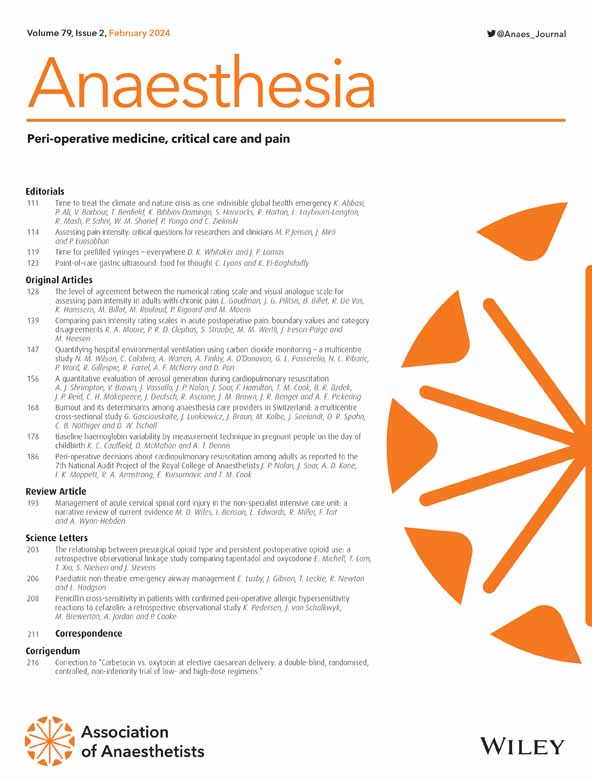发生率,风险因素,管理和产科麻醉实践的高神经轴阻滞的结果:一项前瞻性的国家观察研究使用英国产科监测系统
IF 6.9
1区 医学
Q1 ANESTHESIOLOGY
引用次数: 0
摘要
在英国,高神经轴传导阻滞已被确定为产妇心脏骤停的主要原因。有必要调查产科发生高轴神经阻滞的潜在危险因素和原因,以减少其发生。方法:我们使用英国产科监测系统调查英国产科护理中出现的高神经轴传导阻滞的发生率、危险因素、管理和结局。高神经轴传导阻滞被定义为需要通气支持和/或心肺复苏的脊髓和/或硬膜外麻醉/镇痛。结果2017 - 2019年共报告高神经轴传导阻滞89例。估计总发生率为14.7/10万(95%CI 11.8-18.0)神经轴阻滞,脊髓麻醉后高神经轴阻滞发生率为19.6/10万(95%CI 14.9-25.3),硬膜外镇痛或麻醉后发生率为7.0/10万(95%CI 4.6-10.1)。在高位神经轴阻滞之前,最常见的麻醉干预是分娩后硬膜外镇痛后的单次脊髓注射(占所有病例的43/89),其中37%(16/43)发生在硬膜外补顶不成功后,硬膜外镇痛转为麻醉。89例中有15例发生意外硬脑膜穿刺。有6例心脏骤停。没有产妇或新生儿死亡。据报道,7例患者在气管插管过程中由于高神经轴阻滞及其处理而出现心理困扰和/或意识障碍。结论:虽然高神经轴阻滞在英国产科实践中很少见,并且通常管理良好,但对临床实践关键方面的直接关注可能会降低风险。这些策略包括通过诱导脊髓麻醉将急性仰卧位低血压降至最低;谨慎的鞘内局麻剂量;剖宫产硬膜外镇痛转麻醉的病例选择。本文章由计算机程序翻译,如有差异,请以英文原文为准。
Incidence, risk factors, management and outcomes of high neuraxial block in obstetric anaesthetic practice: a prospective national observational study using the UK Obstetric Surveillance System
SummaryIntroductionHigh neuraxial block has been identified as a leading cause of maternal cardiac arrest in the UK. There is a need to investigate the potential risk factors and causes of high neuraxial block in obstetrics to reduce its occurrence.MethodsWe investigated the incidence, risk factors, management and outcomes of high neuraxial block presenting in maternity care in the UK using the UK Obstetric Surveillance System. High neuraxial block was defined as spinal and/or epidural anaesthesia/analgesia that required ventilatory support and/or cardiopulmonary resuscitation.ResultsThere were 89 reports of high neuraxial block reported between 2017 and 2019. The estimated overall incidence was 14.7/100,000 (95%CI 11.8–18.0) neuraxial blocks, with the incidence of high neuraxial block of 19.6/100,000 (95%CI 14.9–25.3) after spinal anaesthesia and 7.0/100,000 (95%CI 4.6–10.1) after epidural analgesia or anaesthesia. The most common anaesthetic intervention that preceded a high neuraxial block was a single‐shot spinal following labour epidural analgesia (43/89 of all cases), of which 37% (16/43) occurred after an unsuccessful epidural top‐up to convert epidural analgesia to anaesthesia. Inadvertent dural puncture occurred in 15/89 cases. There were six cases of cardiac arrest. There were no maternal or neonatal deaths. Seven patients were reported to have been psychologically distressed and/or had awareness during tracheal intubation because of the high neuraxial block and its management.ConclusionWhilst high neuraxial block is rare in UK obstetric practice and generally managed well, directed attention to key aspects of clinical practice may ameliorate the risk. These include strategies to minimise acute supine hypotension with induction of spinal anaesthesia; prudent intrathecal local anaesthetic dosing; and careful case selection for converting epidural analgesia to anaesthesia for caesarean birth.
求助全文
通过发布文献求助,成功后即可免费获取论文全文。
去求助
来源期刊

Anaesthesia
医学-麻醉学
CiteScore
21.20
自引率
9.30%
发文量
300
审稿时长
6 months
期刊介绍:
The official journal of the Association of Anaesthetists is Anaesthesia. It is a comprehensive international publication that covers a wide range of topics. The journal focuses on general and regional anaesthesia, as well as intensive care and pain therapy. It includes original articles that have undergone peer review, covering all aspects of these fields, including research on equipment.
 求助内容:
求助内容: 应助结果提醒方式:
应助结果提醒方式:


